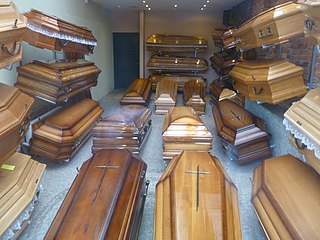
A coffin is a funerary box used for viewing or keeping a corpse, either for burial or cremation.

A box is a container used for the storage or transportation of its contents. Most boxes have flat, parallel, rectangular sides. Boxes can be very small or very large, and can be used for a variety of purposes from functional to decorative.

A lunch box refers to a hand-held container used to transport food, usually to work or to school. It is commonly made of metal or plastic, is reasonably airtight and often has a handle for carrying.

A catafalque is a raised bier, box, or similar platform, often movable, that is used to support the casket, coffin, or body of a dead person during a Christian funeral or memorial service. Following a Roman Catholic Requiem Mass, a catafalque may be used to stand in place of the body at the absolution of the dead or used during Masses of the Dead and All Souls' Day.
A sandbox is a sandpit, a wide, shallow playground construction to hold sand, often made of wood or plastic.

A reliquary is a container for relics. A portable reliquary may be called a fereter, and a chapel in which it is housed a feretory.

Stumpwork or raised work is a style of embroidery in which the stitched figures are raised from the surface of the work to form a 3-dimensional effect.

A tin box is a tinplate container. Tinplate metal is primarily steel with a very thin tin coating. Tin-free steel is also used. In some cultures, these boxes or cans are referred to as "tin boxes" or sometimes even "tins". Many “tin boxes” have hinged or removable lids or covers. Some people collect tin boxes as a hobby.

A casket is a decorative box or container that is usually smaller than a chest and is typically decorated. In recent centuries they are often receptacles for trinkets and jewels, but in earlier periods, when other types of container and drawers in furniture were rarer, and the amount of documents held by the typical person far fewer, they were used for keeping important documents and many other purposes. The many caskets whose decoration suggests they were intended for women probably held cosmetics and perfume, or jewels and documents. Many ancient caskets are reliquaries, for both Buddhist and Christian relics.

The Bimaran casket or Bimaran reliquary is a small gold reliquary for Buddhist relics that was found inside the stupa no.2 at Bimaran, near Jalalabad in eastern Afghanistan.

Ivory carving is the carving of ivory, that is to say animal tooth or tusk, generally by using sharp cutting tools, either mechanically or manually. Objects carved in ivory are often called "ivories".

Tea utensils are the tools and utensils used in chadō, the art of Japanese tea.

A decorative box is a form of packaging that is generally more than just functional, but also intended to be decorative and artistic. Many such boxes are used for promotional packaging, both commercially and privately. Historical objects are usually called caskets if larger than a few inches in more than one dimension, with only smaller ones called boxes.
The Funeral Rule, enacted by the Federal Trade Commission on April 30, 1984, and amended effective 1994, was designed to protect consumers by requiring that they receive adequate information concerning the goods and services they may purchase from a funeral provider.

The Agate Casket of Oviedo is an elaborately decorated box, casket or small chest given by King Fruela II of Asturias and his wife Nunila to the Cathedral of San Salvador, Oviedo, Spain. This masterpiece of 10th century Asturian gold work is kept in the Cámara Santa treasury.

A chasse, châsse or box reliquary is a shape commonly used in medieval metalwork for reliquaries and other containers. To the modern eye the form resembles a house, though a tomb or church was more the intention, with an oblong base, straight sides and two sloping top faces meeting at a central ridge, often marked by a raised strip and decoration. From the sides there are therefore triangular "gable" areas.

Pastiglia[paˈstiʎʎa], an Italian term meaning "pastework", is low relief decoration, normally modelled in gesso or white lead, applied to build up a surface that may then be gilded or painted, or left plain. The technique was used in a variety of ways in Italy during the Renaissance. The term is mostly found in English applied to gilded work on picture frames or small pieces of furniture such as wooden caskets and cassoni, and also on areas of panel paintings, but there is some divergence as to the meaning of the term between these specialisms.

The Esquiline Treasure is an ancient Roman silver treasure that was found in 1793 on the Esquiline Hill in Rome. The hoard is considered an important example of late antique silver work from the 4th century AD, probably about 380 for the major pieces. Since 1866, 57 objects, representing the great majority of the treasure, have been in the British Museum.
Strong box or strongbox may refer to:

Plácido Maria Martin Zuloaga y Zuloaga was a Spanish sculptor and metalworker. He is known for refining damascening, a technique that involves inlaying gold, silver, and other metals into an iron surface, creating an intricate decorative effect. Zuloaga came from a family of Basque metalworkers. He was the son of damascening pioneer Eusebio Zuloaga, the half-brother of the artist Daniel Zuloaga, and the father of the painter Ignacio Zuloaga. Taking over his father's armaments factory, he adapted it to make art pieces which he exhibited at international fairs, winning multiple awards.
















